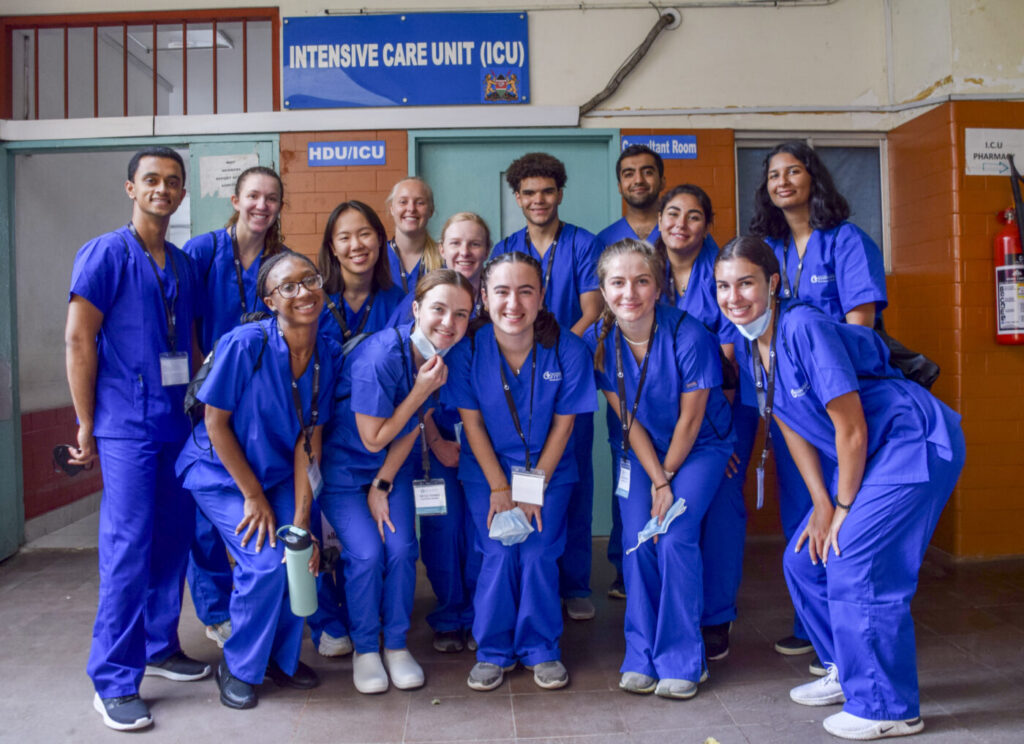Physician assistants tend to work in primary care fields, although their role in healthcare continues to evolve. Increasingly, PAs are playing important roles in a variety of medical specialties and subspecialties. As the scope of practice for PAs continues to grow, so too does the number of ways PAs can specialize their careers.
If you’re considering becoming a PA, or if you’re already a PA student wondering what sort of specialty you might want to pursue, read on to learn about some of the types of physician assistants and where they work, physician assistant specialties, how to specialize as a PA, and more.
What Do Physician Assistants Do?
As the American Academy of PAs (AAPA) explains, the physician assistant role was created in the mid-1960s to help address a shortage of primary care physicians. The original training curriculum, penned by Eugene A. Stead Jr., MD of Duke University, was inspired by the quick and effective training programs developed for doctors in World War II.
From 1967 on, physician assistants became authorized to practice medicine in all 50 states, obtained prescriptive authority, and, in 2019, were first enabled by a state (North Dakota) to practice medicine without physician supervision. As time goes on, the role of physician assistants becomes larger in scope and more important in healthcare delivery.
Physician assistants (PAs) are medical professionals who provide care and treatment under the supervision of a licensed physician. PAs take on many of the same responsibilities as doctors, including conducting physical exams, diagnosing and treating illnesses, ordering and interpreting tests, and prescribing medication. In addition, PAs may also provide patient education, conduct research, and assist in surgery. The scope of practice for physician assistants varies by state, but they are generally allowed to perform most tasks that are within the scope of licensed physicians.
With an ongoing physician shortage in many areas and the growing demand for healthcare services, PAs are expected to play an increasingly important role in meeting the needs of patients. As a result, a career as a PA can be both challenging and rewarding.
Physician assistant specialties are many and varied, though the majority of PAs work in primary care fields.
Scope of Practice
The lawful scope of practice for physician assistants will vary depending on training, workplace policies, and state law. In most states, a PA’s supervising/collaborating physician will define the scope of practice (taking into account state law).
How Do Physician Assistants Specialize?
PAs specialize after completing an accreditated PA program and obtaining a master’s degree, becoming certified and licensed to practice, and entering the workforce. Physician assistant school consists of general medical education that prepares students to become certified and licensed to practice in any specialty. Although elective coursework in specialties is usually offered and can provide helpful exposure, additional training is not required to begin working in a specialty. Post-graduate training programs give PAs additional education in a particular area of medicine, such as surgery, ICU/ER, or psychiatry.
The flexibility to choose a specialty, or to change specialties, without committing to years of post-graduate education is one of the many advantages of becoming a PA. Once PAs enter a specialty, they gain experience that makes them competitive in that specialty’s job market, but PAs are certified to work in any specialty, regardless of their initial career path.
Generally, PAs find their niche and begin to specialize during their first or second job out of PA school — which is to say, PAs generally find a specialty they like and stick with it. Many PAs work in the same specialty for their entire career, while others move between physician assistant specialties or seek additional education as their interests change.
In short, PAs are certified as generalists and then receive on-the-job training that allows them to perform the tasks necessary to that specialty. PA specialties are usually a result of work experience and training provided by physicians and employers.
Types of Physician Assistants
Here’s an overview of the general types of physician assistants, their work environment, and their general responsibilities.
1. Outpatient Physician Assistant
Outpatient PAs work in settings such as clinics, physician offices, and urgent care centers. They treat patients of all ages for a wide variety of conditions, both acute and chronic. Outpatient PAs may also provide preventative care, including immunizations and health screenings. They may also assist in surgery and perform minor procedures, such as biopsies and suturing.
2. Inpatient Physician Assistant
Inpatient PAs work in hospitals and other settings, such as nursing homes and rehabilitation centers. They care for patients who have been admitted for treatment of serious conditions, such as heart attacks and strokes. Inpatient PAs may also provide care for patients who are recovering from surgery or have chronic conditions that require close monitoring.
3. Emergency Room/Urgent Care Physician Assistant
Emergency room/urgent care PAs work in settings such as emergency rooms, urgent care centers, and trauma centers. They provide care for patients with a wide variety of conditions, from minor injuries to life-threatening illnesses. Emergency room/urgent care PAs must be able to think quickly and make decisions under pressure. They must also be able to handle a high volume of patients in a fast-paced environment.
4. Psychiatry Physician Assistant
Psychiatry PAs work in settings such as hospitals, mental health clinics, and private practices. They provide care for patients with mental illness and emotional disorders. Psychiatry PAs may also provide care for patients with substance abuse disorders.
5. Surgery Physician Assistant
Surgery PAs work in settings such as hospitals, surgical centers, and private practices. They assist surgeons during surgery and provide care for patients before and after surgery. Surgery PAs may also perform some procedures, such as biopsies and suturing.
PA Specialties in 2022
In this section, we’ll take a look at specific PA specialties and discuss the unique responsibilities of each type of PA. Most PAs work in primary care fields, and this list is presented no particular order.
Pediatrics PA
In pediatrics, the physician assistant’s responsibilities depend on the child’s age. You care for patients ranging from infants to young adults. In an outpatient setting, you perform well and sick child visits. Immunizations, screening, and physical exams are part of routine well visits. Sick visits include assessing, diagnosing, and treating injuries and illnesses. You deal with everything from ordering further diagnostic tests like x-rays and prescribing therapies like physical therapy to writing prescriptions for drugs. Physician assistants who specialize in pediatrics may also work in hospitals or other inpatient settings. In a hospital, your tasks and responsibilities could range from caring for children with general issues to working with a specialty like cardiology or treating critically ill patients.
Radiology PA
PAs in radiology work in interventional radiology, CT, and MRI. Minor interventional radiology (IR) procedures are performed by PAs in IR. In more complicated and invasive procedures, you collaborate with the Interventional Radiologist. PAs who work in MRI or CT interpret findings and order protocols. As a physician assistant in radiology, you administer blood products and fluids when required and provide medications through all methods. Documenting physical exams and procedures, as well as writing progress reports, is also expected. In radiology, PAs conduct radiology rounds and work as a team.
Obstetrics and Gynecology (OB/GYN) PA
OB/GYN PAs care for a variety of patients in clinical and inpatient settings. Some responsibilities include pre- and post-natal care, family planning, and performing annual breast and pelvic exams. You may also be called upon to deal with issues of infertility and gynecological conditions. Inpatient OB/GYN physician assistant responsibilities include performing fetal heart monitoring, ultrasounds, and other diagnostics. Internal monitor placement, cryotherapy, and colposcopies are examples of OB/GYN procedures a PA may perform. Advanced procedures require PAs to assist surgeons.
Neurology PA
PAs in neurology, as with any specialty, work as part of a team. The general sequence of a neurological diagnosis begins with PAs and neurologists reviewing patient medical histories and general assessments of the neurological system. From there, specialized diagnostics are employed. Finally, PAs and neurologists interpret findings and arrive at a diagnosis. The responsibilities of a neurology PA depend on the specific clinical setting. PAs may assist neurosurgeons in invasive procedures.
Internal Medicine PA
Physician assistants in internal medicine work with a variety of patients, from healthy adults in need of simple check-ups to patients with medical conditions and complicated histories. Physicians and PAs in internal medicine receive patients referred by general practioners. Career internal medicine PAs often treat individuals over an extended period of time and work in a hospital or office. Patients may be diagnosed with one or more conditions, and PAs work to acquire and interpret medical histories to arrive at a diagnosis and provide adequate care. Inpatient internal medicine PAs interpret ultrasound, X-Ray, and EKG findings and perform some bedside procedures. Specific responsibilities will vary by subspecialties, such as oncology, immunology, hematology, and cardiology.
Subspecialties of Internal Medicine:
- Endocrinology
- Rheumatology
- Pulmonology
- Hematology & oncology
- Infectious disease
- Neurology
- Critical care
- Gastroenterology
- Nephrology
- Cardiology
General Practice PA
In general practice, PAs tend to non-critical medical issues and refer patients to specialists when necessary. You record and review patient medical histories and perform physical exams. PAs in general practice also treat common conditions, write prescriptions, and provide immunizations. Collecting patient data, maintaining accurate records, and providing education are other important responsibilities.
Family Medicine PA
PAs in family medicine provide primary care for adults and children. You prescribe medications, order and interpret diagnostic tests, treat and diagnose patients, refer patients to specialists, and sometimes perform minor surgeries. PAs in family medicine also provide patient education on topics such as diet, exercise, and disease prevention as well as educating patients about any diagnoses. You may work in a solo practice or as part of a team. PAs in family medicine also acquire an intimate understanding of a family’s medical history and treat chronic conditions over time.
Subspecialties of Family Medicine:
- Hospice and Palliative Medicine
- Sports Medicine
- Sleep Medicine
- Pain Medicine
- Geriatric Medicine
- Adolescent Medicine
Otolaryngology PA
PAs working in otolaryngology treat and diagnose conditions and injuries of the ear, nose, and throat (ENT). ENT physician assistants may perform procedures such as nasal endoscopy, fiberoptic laryngoscopy, excision of lesions, removing foreign bodies, and post-op debridement. For more complex cases, PAs assist ENT physicians with diagnosis and treatment. You are authorized to diagnose, treat, and refer most patients.
Subspecialties of Otolaryngology (ENT):
- Rhinology
- Pediatric Otolaryngology
- Neurotology
- Laryngology
- Head and Neck Surgery
- Facial Reconstruction Surgery
Emergency Medicine PA
Emergency medicine PAs work in hospital emergency departments and urgent care clinics. You treat patients with a wide range of conditions, triage patients, perform procedures, and treat life-threatening injuries. Emergency medicine PAs must be able to make quick decisions and act fast in high-pressure situations. You also need to be able to handle emotional stress and have excellent communication skills. Taking and interpreting patient medical histories, ordering and interpreting diagnostic tests, and prescribing medications are other important responsibilities. Thoracentesis, casting and splinting, and laceration repair are some examples of procedures performed in emergency medicine.
Subspecialties of Emergency Medicine:
- Critical Care Medicine
- Undersea and Hyperbaric Medicine
- Emergency Medical Services
- Sports Medicine
- Pediatric Emergency Medicine
- Wilderness Medicine
- Medical Toxicology
- Palliative Medicine
Dermatology PA
PAs in dermatology work as part of a team to diagnose and treat patients with a variety of skin, nail, and hair conditions. You take patient medical histories, perform physical exams, order and interpret diagnostic tests, prescribe medications, and perform minor surgeries. PAs also provide patient education on topics such as sun protection and skin cancer prevention. You may also perform cosmetic procedures such as botox injections and dermal fillers. Dermatology PAs often work in a private practice setting or specialist clinic, but also work in medical offices and hospitals.
Subspecialties of Dermatology:
- Teledermatology
- Pediatric dermatology
- Mohs surgery
- Immunodermatology
- Dermatopathology
- Cosmetic dermatology
Cardiology PA
Diagnosis and treatment, surgery assistance, prescribing medicine, and ordering and interpreting tests are all part of a cardiology PA’s job. You will also provide patient education on heart-healthy lifestyle choices, such as diet and exercise. Cardiology PAs often work in hospitals or private practices. Some PAs specialize in interventional cardiology, which is a subspecialty that focuses on minimally invasive procedures to treat heart conditions. Interventional cardiology PAs often work in hospital settings. Other inpatient cardiology PA responsibilities include performing rounds, physical check-ups, and consultations as well as documenting patient histories and writing discharge summaries. Common outpatient cardiology PA duties include patient education, consultations, prescribing medication, and conducting follow-up care.
Subspecialties of Cardiology:
- Electrophysiology
- Interventional Cardiology
- Advanced Heart Failure and Transplant Cardiology
- Cardiovascular Disease
- Adult Congenital Heart Disease
- Preventative Cardiology
- Pediatric Cardiology
Anesthesia PA
Anesthesia PAs work with anesthesiologists to provide care before, during, and after surgery. You take patient medical histories, perform physical exams, order and interpret diagnostic tests, prescribe medications, and administer anesthesia. Anesthesia PAs also monitor patients’ vital signs during surgery and provide post-operative care. Some PAs specialize in a particular type of anesthesia, such as pediatric, cardiothoracic, or neurosurgical anesthesia. Anesthesia PAs often work in hospital operating rooms but may also work in other settings such as pain management clinics, ambulatory surgery centers, and dental offices.
Subspecialties of Anesthesia:
- Hospice and palliative anesthesia
- Pediatric anesthesia
- Regional anesthesia
- Obstetric anesthesia
- Neurosurgical anesthesia
- Critical care anesthesia
- Cardiothoracic anesthesia
Surgery PA
Surgery PAs work with surgeons to provide care before, during, and after surgery. PAs in surgery are trained in preventative, surgical, therapeutic, and diagnostic care. They may work in many roles, such as pharmaceutical liaison, medical committees, researcher, post-op, and surgery assistant. Specific tasks will depend on the subspecialty. PAs in surgery often work in hospital operating rooms but may also work in other settings such as ambulatory surgery centers, outpatient surgical centers, and physician offices.
Subspecialties of Surgery:
- Urology
- General surgery
- Pediatric surgery
- Vascular surgery
- Cardiovascular/cardiothoracic surgery
- Plastic surgery
- Transplant surgery
- Trauma surgery
- Colon & rectal surgery
- Orthopedic surgery
- Neurosurgery
- Bariatric surgery
- Otolaryngology
- Thoracic surgery
- Oncology surgery
How to Get Into PA School
To become a certified and licensed PA, you must first complete a physician assistant degree progam. To apply to PA programs at institutions accreditated by the ARC-PA, you’ll need:
- A bachelor’s degree
- Adequate GRE scores and GPA
- Perform well in and complete prerequisite coursework
- Letters of recommendation
- Relevant pre-PA experience, volunteer CV, and a personal statement
Requirements vary by program, but the above list is generally expected of applicants.
During college, keeping your GPA high and successfully completing prerequisite coursework will be crucial to getting into the PA program of your choice. You’ll also want to make sure you’re taking the GRE and doing well on the exam.
For many schools, your experiences—both professional and volunteer—will be highly considered during the admissions process. So, make sure to document your experience in healthcare or other relevant fields and get strong letters of recommendation from your references.
Your personal statement is another key part of your application. In this essay, you’ll want to highlight why you’re interested in becoming a PA, what you hope to accomplish in your career, and how the specific PA program you’re applying to will help you reach your long-term goals.
For those looking to increase their chances to getting into PA programs across the country, we highly recommend:
- PA School Admissions Consulting
- Pre-Pa Internships
Utilize PA School Admissions Consulting
Applying to PA programs is a competitive process, and working with an admissions consultant can significantly increase your chances of getting into the programs you’re interested in. Admissions consultants have experience with the PA school admissions process and will be able to guide you through every step, from choosing the right programs to applying successfully.
One of the main benefits of working with an admissions consultant is that they can help you identify your individual strengths and weaknesses as an applicant, based on decades of medical and educational expertise.
Admissions consultants will also help you prepare for interviews, write your personal statement, and fill out your application.
Here at IMA, we’ve helped thousands of students just like you get into medical schools and healthcare programs across the country. We believe effective one-on-one guidance takes the guesswork out of the admissions process and allows you to focus on becoming the best applicant possible.
Scheduling a free consultation is easy! In the meantime, you can explore some of our other resources, such as our pre-health blog. If you’re applying to PA programs, you might be interested in 10 Easiest PA Schools to Get Into in 2022 or How to Choose the Best PA Major.

Enroll in Pre-PA Internships
One of the most exciting and effective ways to get meaningful clinical experience and stand out during the application process is through IMA’s Pre-PA Internships. Our interns work with handpicked physicians, PAs, nurses, and other healthcare providers acorss the world to deliver competent, compassionate healthcare to some of the world’s most underserved populations.
We offer focused learning experiences in many of the PA specialties and subspecialties mentioned in this article and interns may pursue multiple specialties throughout the program. This can help you explore your career options, demonstrate to admissions that you are interested in a specialty, and make you a more competitive applicant for future employers.
Most of all, our interns learn what daily healthcare delivery entails. Our alumni have gone on to top medical schools across the country, in part thanks to the inspiriation and knowledge they acquired through IMA’s internships abroad.
Our Pre-PA Internships are an excellent way to get clinical experience, develop your skills as a healthcare provider, and make a difference in the lives of others—all while gaining an edge in the PA school admissions process.
The Future of PAs in Healthcare Delivery
Research from the National Center for Health Statistics and other studies shows that physician assistants are increasingly relied upon as a source of primary care. The Bureau of Labor Statistics projects that a 31 percent increase in employment from 2020 to 2030.
Statistically, PAs treat a higher percentage of young and uninsured patients and patients insured by Children’s Health Insurance Program (CHIP) and Medicaid. PAs are relied upon most heavily in nonteaching hospitals.
The National Center for Health Statistics has also seen a rise in PAs conducting preventative care visits. Many see the role of the physician assistant continuing to extend beyond physician care healthcare delivery.
PAs are also taking on more executive and managerial roles in medicine and increasingly becoming the primary healthcare provider for primary care visits. Some say that physicians are poised to take on a more administrative and managerial role, coordinating PA healthcare delivery and focusing on critical and complex cases.
PAs will continue to be utilized increasingly in a variety of medical practice settings, including primary care, throughout American medicine. They’ve been proven to be both clinically and economically effective practitioners. They allow healthcare sites to expand their services and improve the delivery of care for underserved populations. There is no question that PAs have become an important component of the U.S. healthcare workforce.





